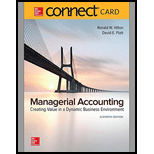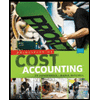
1.
Prepare an operating income statement of Company L for both years under absorption costing method.
1.
Explanation of Solution
Absorption Costing: “Absorption costing is a method that allocates “direct labor, direct materials, fixed manufacturing
Prepare an operating income statement of Company L for both years under absorption costing method as follows:
| Operating income statement under absorption costing method | ||
| Particulars | Year 1 | Year 2 |
| Sales revenue (1) (C) | $ 125,000 | $ 125,000 |
| Less: Cost of goods sold: | ||
| Beginning finished-goods inventory (3) | $ 0 | $10,500 |
| Cost of goods manufactured (2) | 63,000 | 56,000 |
| Cost of goods available for sale | $63,000 | $66,500 |
| Ending finished-goods inventory (3) | 10,500 | $ 0 |
| Cost of goods sold (D) | $52,500 | $66,500 |
| Gross margin | $72,500 | $58,500 |
| Less: Selling and administrative expenses | $ 45,000 | $ 45,000 |
| Operating income | $27,500 | $13,500 |
Table (1)
Working note (1):
Calculate the value of sales revenue for both years.
| Particulars | Production units (A) | Year 1 |
Year 2 |
| Sales revenue | 2,500 units | $15.00 | $1,875,000 |
Table (2)
Working note (2):
Calculate the cost of goods manufactured for both years.
Year 1:
Year 2:
Working note (3):
Calculate the cost of ending inventory for year 1:
Note: The ending inventory for year 1 is considered as the beginning inventory for year 2.
2.
Prepare an operating income statement of Company L for both years under variable costing method.
2.
Explanation of Solution
Variable Costing: Managers frequently use variable costing for internal purposes for taking decision making. The cost of goods manufactured includes direct materials, direct labor, and variable factory overhead. Fixed factory overhead treated as period (fixed) expense.
Prepare an operating income statement of Company L for both years under variable costing method as follows:
| Particulars | Year 1 | Year 2 |
| Sales revenue (E) (1) | $ 125,000 | $ 125,000 |
| Less: Cost of goods sold: | ||
| Beginning finished-goods inventory | $ 0 | $3,500 |
| Cost of goods manufactured | 21,000 | 14,000 |
| Cost of goods available for sale | $21,000 | $17,500 |
| Ending finished-goods inventory (4) | $3,500 | $0 |
| Cost of goods sold | $17,500 | $17,500 |
| Add: Variable selling and administrative costs | $25,000 | $25,000 |
| Total variable costs (F) | $42,500 | $42,500 |
| Contribution margin | $82,500 | $82,500 |
| Less: Fixed costs: | ||
| Manufacturing | $42,000 | $42,000 |
| Selling and administrative | $20,000 | $20,000 |
| Total fixed costs | $62,000 | $62,000 |
| Operating income | $20,500 | $20,500 |
Table (3)
Working note (4):
Calculate the cost of ending inventory for year 1:
Note: The ending inventory for year 1 is considered as the beginning inventory for year 2.
3.
Reconcile the operating income reported under variable and absorption costing for year 1 and year 2.
3.
Explanation of Solution
Reconcile the operating income reported under variable and absorption costing for year 1 and year 2as follows:
Year 1:
In this case, the operating income of Company L is higher under absorption costing, because the production units (3,000 units) are more than the sales units (2,500 units), and under absorption costing the fixed overhead is inventoried until when the manufactured goods are sold. Hence, the fixed overheads for 5,000
Working note (5):
Calculate the predetermined fixed overhead rate.
Year 2:
In this case, the operating income of Company L is higher under variable costing, because the fixed overhead under variable costing is calculated only for current year production units (2,000 units), and the changes in the production and sales units is not consider. But in the absorption costing, the fixed overhead incurred in the prior year (500 units of inventory) increases the current year fixed overhead and the fixed overhead under absorption costing is comparatively higher than the variable costing. Hence, when the production units are less than the sales units, then the operating income ($20,500) under variable costing should be higher than the absorption costing ($13,500).
Want to see more full solutions like this?
Chapter 8 Solutions
Connect 1-Semester Access Card for Managerial Accounting: Creating Value in a Dynamic Business Environment (NEW!!)
- What is the book value at the end of year 8 on these financial accounting question?arrow_forward??!arrow_forwardWhat is the purpose of the “trial balance” in financial accounting?a) To prepare financial statementsb) To verify the accuracy of debit and credit entriesc) To calculate net incomed) To record adjusting entriesarrow_forward
- Which of the following represents the accounting equation?a) Assets = Liabilities + Equityb) Assets + Liabilities = Equityc) Assets – Liabilities = Equityd) Assets + Equity = LiabilitiesAnswer: a) Assets = Liabilities + Equityarrow_forwardWhat will the net proceeds from selling the assets be ?arrow_forwardWhat do you know about managerial accounting? explain this topicarrow_forward
 Principles of Cost AccountingAccountingISBN:9781305087408Author:Edward J. Vanderbeck, Maria R. MitchellPublisher:Cengage Learning
Principles of Cost AccountingAccountingISBN:9781305087408Author:Edward J. Vanderbeck, Maria R. MitchellPublisher:Cengage Learning Managerial AccountingAccountingISBN:9781337912020Author:Carl Warren, Ph.d. Cma William B. TaylerPublisher:South-Western College Pub
Managerial AccountingAccountingISBN:9781337912020Author:Carl Warren, Ph.d. Cma William B. TaylerPublisher:South-Western College Pub Cornerstones of Cost Management (Cornerstones Ser...AccountingISBN:9781305970663Author:Don R. Hansen, Maryanne M. MowenPublisher:Cengage Learning
Cornerstones of Cost Management (Cornerstones Ser...AccountingISBN:9781305970663Author:Don R. Hansen, Maryanne M. MowenPublisher:Cengage Learning- Principles of Accounting Volume 2AccountingISBN:9781947172609Author:OpenStaxPublisher:OpenStax College
 Financial And Managerial AccountingAccountingISBN:9781337902663Author:WARREN, Carl S.Publisher:Cengage Learning,
Financial And Managerial AccountingAccountingISBN:9781337902663Author:WARREN, Carl S.Publisher:Cengage Learning, Managerial Accounting: The Cornerstone of Busines...AccountingISBN:9781337115773Author:Maryanne M. Mowen, Don R. Hansen, Dan L. HeitgerPublisher:Cengage Learning
Managerial Accounting: The Cornerstone of Busines...AccountingISBN:9781337115773Author:Maryanne M. Mowen, Don R. Hansen, Dan L. HeitgerPublisher:Cengage Learning





